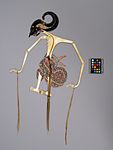wayang kulit (Shadow Puppet)
About this object
History of use
Wayang kulit, shadow puppets, are gilded, intricately painted and finely perforated so as to cast large shadows on a screen during night-long storytelling performances throughout Indonesia. The dalang, or puppeteer, narrates the Wayang Purwa stories. The size, colour and carving patterns of wayang kulit were standardized under the Islamic rule of King Radan Patah in the sixteenth century, when new laws prohibited the depiction of human forms. Shadow puppets were produced in a variety of styles.
Iconographic meaning
Puppet depicts the character Arjuna, of the Hindu epic Mahabharata. The colour black used on the character’s face is to symbolize his maturity and serenity.
Physical description
Shadow puppet of male figure with black face in profile. Long neck, with six black lines, projecting out from body. Long nose, open mouth with three teeth. Hair tied into curved and pointed shape with gold coloured attachment. Skirt has brightly coloured design and chest is bare. Hair and skirt finely perforated. Long, jointed arms attached to controlling rods. Ring on each hand with three red circles on it. Feet are joined heel to toe by red strip. The shoulders and elbows are rotatable and a marionette stick is attached through the palm of each hand.
